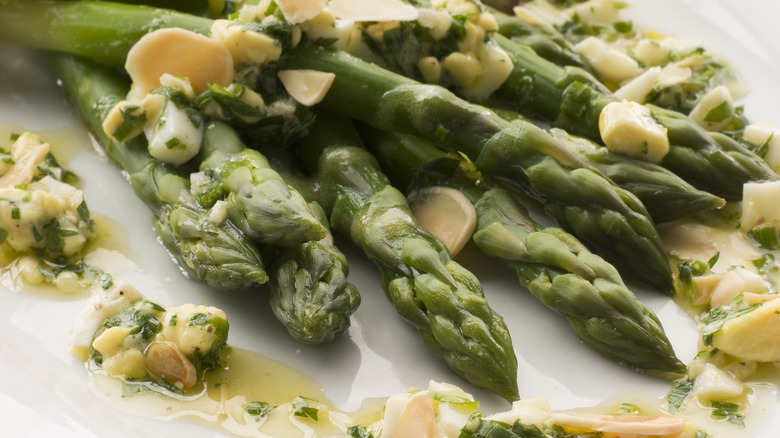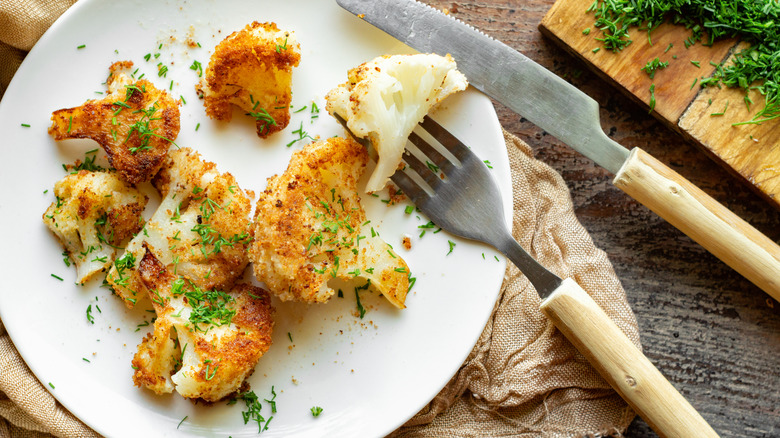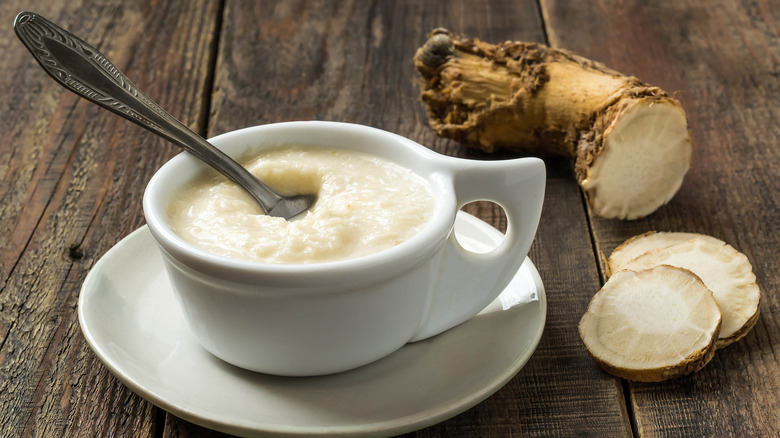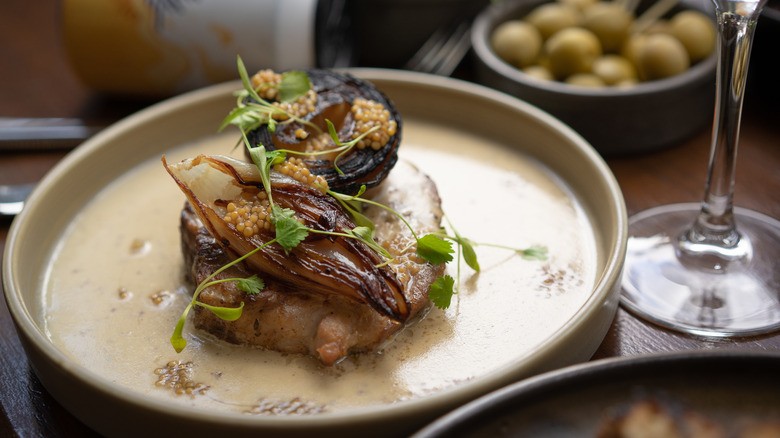The 2 Different Meanings Of à La Polonaise On A Menu
À la Polonaise, French for "in Polish style" or "in the manner of Poland," can be described as a French take on Polish cooking. If you see à la Polonaise on a menu, it could either refer to a way of garnishing a vegetable dish or a type of sauce. Any vegetable à la Polonaise is usually sprinkled with browned breadcrumbs, finely chopped hard-boiled eggs, and herbs. Although the history of this culinary term is murky, it's highly likely that the Polish-born Queen Marie Leszczynska, who was married to Louis XV, introduced Polish-style vegetables to France in the 18th century.
The origins of sauce à la Polonaise are obscure, and the ingredients vary between recipes. In the seminal "Art of French Cooking in the 19th Century," French culinary giant Marie-Antoine Carême did his due diligence to understand the taxonomy of countless French sauces. Amidst the complex web of French sauces and foreign influences in French cuisine, Carême narrowed it down to the four mother sauces, which are the building blocks of French cooking. Sauce à la Polonaise is a spin-off of one of these mother sauces with the addition of horseradish, lemon, and sour cream, imbuing it with a "Polish" air.
Vegetables à la Polonaise
The most well-known version of making any dish à la Polonaise is to garnish it with golden breadcrumbs, eggs, and herbs such as thyme, parsley, and basil. The most popular vegetables to pair with this delicious garnish are asparagus, cauliflower, wax beans, and broccoli, although most fibrous, hearty vegetables would suit the garnish well. You can choose between baking or steaming the vegetables, although they can taste just as delicious when roasted.
Once you choose your vegetable, you melt butter in a pan and pour breadcrumbs in, coating them evenly in the butter to soak up the milk solids and their rich flavor. A large amount of butter can turn the garnish into a sauce that runs down your vegetables. As the breadcrumbs become golden brown, you can either use the breadcrumbs as a topping by sprinkling them over the vegetables or combine everything in the same pan to make the vegetables evenly coated and delightfully crispy.
The hard-boiled eggs provide a textural contrast with their tender white flesh and chalky yolk. Adding finely chopped eggs can turn an otherwise meager vegetable dish into a satisfying part of your meal. While chopped hard-boiled eggs give you the mouthfeel of an egg salad, a grated egg might work even better, resulting in a fine mountain of egg melting into buttery crumbs.
Sauce à la Polonaise
According to Cook's Info, sauce à la Polonaise is essentially a derivative of sauce velouté, which is a basic sauce made from stock, flour, and butter. Velouté is clean and light in appearance, as it is made with a light roux and light stock (usually fish or chicken stock). As a neutral base, velouté is excellent with a variety of flavor combinations and textures. The Polish-style velouté is made with horseradish, sour cream or crème fraiche, and lemon juice.
This version of sauce à la Polonaise resembles several different sauces in French and Polish cuisines. Horseradish, popular in the Alsace region of France, was used in sauce au raifort, which is French horseradish sauce. This sauce is made from crème fraiche, breadcrumbs, and grated horseradish, which is reminiscent of the breadcrumbs in vegetables à la Polonaise.
The Polish sauce which most likely inspired the French à la Polonaise is sos chrzanowy or hot horseradish sauce. This Polish sauce begins with what is essentially a velouté made from flour, butter, and broth. Then, horseradish, sour cream, and lemon juice are added. Polish horseradish sauce is often served with hardboiled eggs, although its piquant flavor also suits roast beef and potato salad. It's difficult to determine where the sauce truly originated, but sauce à la Polonaise and sos chrzanowy implement ingredients and methods from French and Polish cuisines.
How to tell the difference between the two
If you're at a classic French restaurant or even a modern fusion establishment, you can guess what kind of à la Polonaise a menu is referring to by looking at what it comes with. If the dish is any vegetable à la Polonaise, it will most likely be served with buttery breadcrumbs and finely chopped eggs on top. If the dish is a meat or fish dish, like roast beef or sea bass, it's safe to assume that you'll have a creamy, slightly sour sauce à la Polonaise poured over it.
Then, there are the in-between dishes like hard-boiled eggs, boiled potatoes, french fries, and meatballs that seem to suit both types of Polish-style preparations. In these cases, it'll be best to ask the server what to expect. Because sauce à la Polonaise is not a standardized recipe, it can sometimes come with chopped hardboiled eggs mixed in or it could be called a sauce when it's really just the rich breadcrumb garnish.



